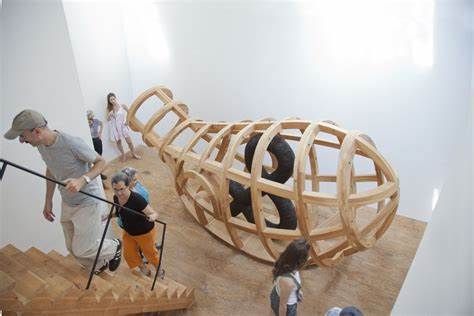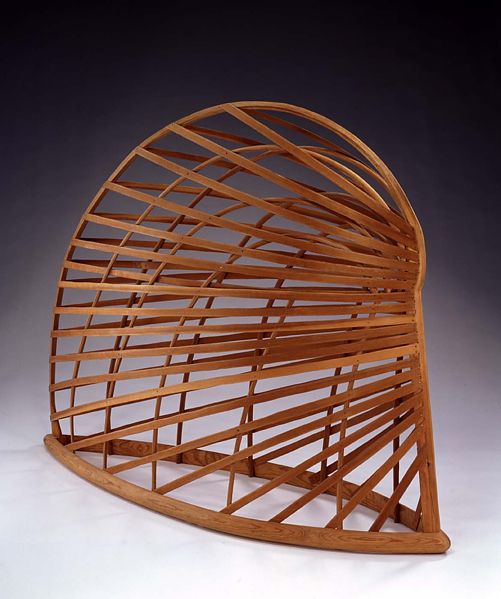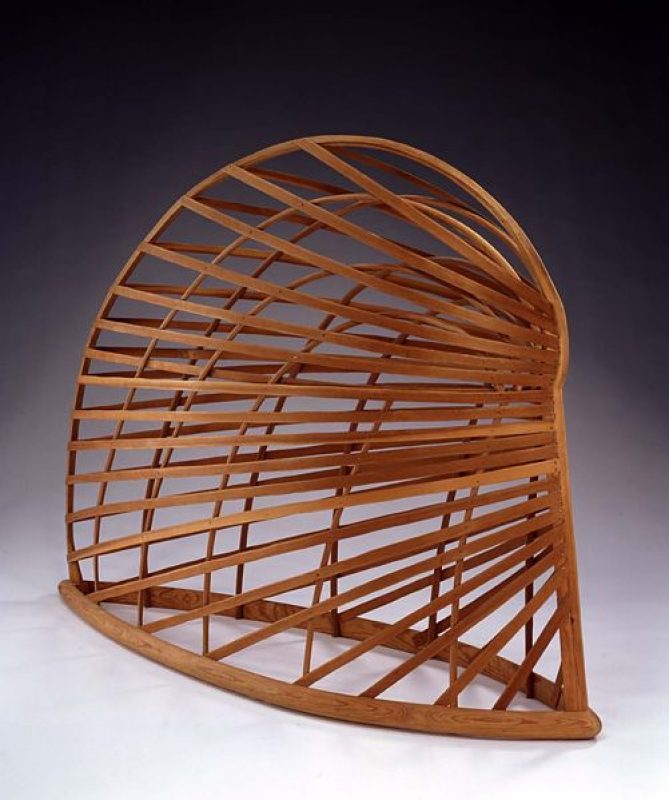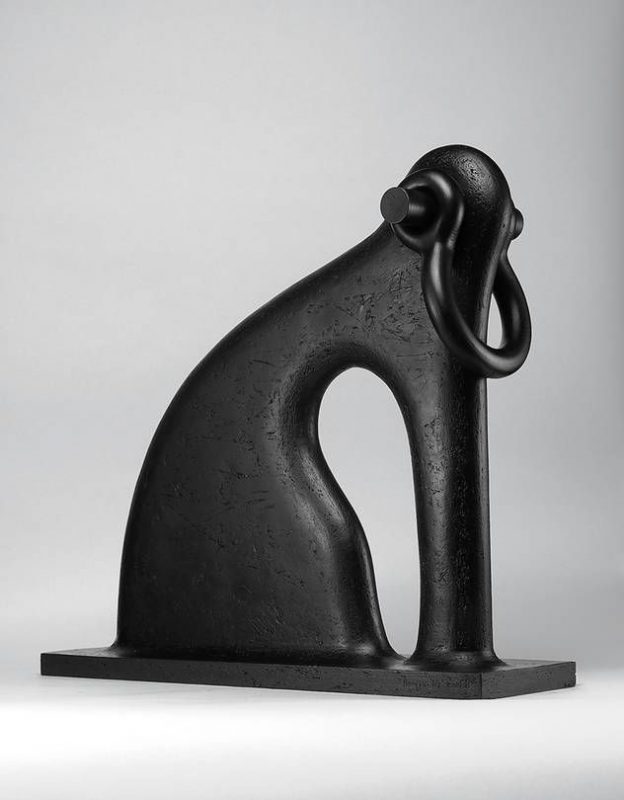“T” Space is a 1000 sq. ft. cedar gallery building in the woods. It stands on steel legs. There are two bridges. One is from the east – for people, the other from the south – for things. Inside is a white plywood space. It is in the plan of the letter “T”. In section there is a double height space. The leg of the “T” has a small balcony. There are two doors and three windows. It was built by Steven Holl. The current exhibit shows a wood sculpture by Martin Puryear. It is called “Vessel.”
AND AND AND
A Note on a Sculpture by Martin Puryear
Carter Ratcliff
Grids imply right angles and sometimes Martin Puryear lets the implication stand, building gridded rectangles into boxy enclosures. A recent solo exhibition included Load, a gridded box on wheels. Vehicular geometry. At “T” Space he is showing Vessel, a large wooden piece from 1997-2002. Here the grid is curved to produce a rounded body with an upward pointing neck. And it has no wheels. Vessel crouches on the ground like a plump bird. Inside stands an ampersand. Covered with a heavy coat of tar, this form is so large and emphatic that its meaning is better rendered not as “and” but as “AND.”
From the side, the ampersand looks like a head and a body, with bent elbows resting on bent knees. Seen this way, it is not standing but sitting, like its pitch-pine enclosure. For all its figurative presence, however, it is still a bit of typography, monumentalized, and one wonders about its referent. The more one wonders, the more possibilities appear—so many that one tries to anchor Vessel to precedents, other sculptures that enclose smaller forms in larger ones. During the 1950s Henry Moore made a series of Helmet Heads, which fit this description precisely. Through gaps in a curved carapace, you see a rounded, skull-like shape. As the artist said in 1967, these sculptures have to do with “the protection idea.” Moreover, “you do not quite know what is inside.” This is true and yet it is undeniable that the inner forms have a human presence and the outer ones look like armor. A narrow reading of the Helmet Heads would conjure up Bronze Age warriors. Giving ourselves more leeway, we might say that Moore evokes private or even secret selves hiding inside the protective shells of social personae.
Robert Morris recapitulated this pattern of inner and outer in Box with a Sound of Its Own Making, 1961, a small wooden cube containing a recording of nails being hammered. The effect is of an object recollecting its own coming into existence. Here the contrast between private and public selves morphs into the Cartesian opposition of body (the tangible box) to mind (intangible sounds bearing symbolic import). At some point in the building of Vessel, Puryear took up the neatly wrapped parcel of inner and outer and calmly broke it wide open. This sculpture is surrounded by the invisible shards of a distinction that Western philosophy has long posited as indispensable.
Because shards imply a violence at odds with Puryear’s sensibility it’s better to let the logic of inner and outer just fade away as we imagine the ampersand uncoiling and gliding free—not a literal possibility, of course, but Puryear encourages no literalist considerations. Nor does he deal in symbols subject to definitive interpretation. His is an art of allusions, implications, grand hints and subtle cues that lead us as far as we are able to go in an unbounded field of possibility. Let’s say, for starters, that the ampersand stands for everything the vessel contains. The trouble with this reading—or the advantage—is that the vessel is so porous that it can’t really be said to contain anything very securely. The space where the ampersand sits is open to everything, and thus, on the metonymic logic of part for whole, it stands for all of space.
And maybe the ampersand itself, this sinuous signifier of “AND,” is a metonymic emblem of objects, the sum total of all the things we call things. But it can have this meaning only linguistically, meaning that Puryear leads us further into the field of meaning by inducing a slippage from thing to word. Because words generate grammar (or is it the other way around?), a sentence unfurls from this point—something about the one and the many as matters of everyday experience and how, as a practical matter, every space delimited by an object entails all of space and every other object, any one of which can serve as the midpoint of an infinite that can be understood spatially or materially or linguistically, given that the grammar of any language must be delimited, that is to say, structured, in a way that permits the generation of an infinite number of sentences—at which further, unmappable point any coherence possessed by this sentence of ours begins to lose itself in the intense and steady light that surrounds Puryear’s structures. We are drawn back to what is visible and, more than that, palpable: details of carpentry and weaving and metal casting.
The curved ribs and struts of Vessel evoke the architecture of boats and old houses in certain varieties of the American vernacular. Yet there is nothing nostalgic about this sculpture. Its forms are crisp and vividly present. Engaging vision, they encourage it to wake up to its speculative power, the energy that propels us from the present of seeing to the future of further understanding, guided by nothing but the sense that the world is not a puzzle to be worked out once and for all but a plenitude that sustains us so long as our attentiveness renews it. To prompt that attentiveness is the purpose of Puryear’s art, or, I should say, one of many purposes, each shading off into the next in a way that reminds me of a line from a poem by Elizabeth Bishop, entitled Over 2,000 Illustrations and a Concordance:
Everything only connected by ‘and’ and ‘and’
When I first read this poem, I heard a tone of deprecation in Bishop’s “only,” a suggestion that some adhesive more powerful than “and” would be desirable. Now I think she is saying it’s good that there is only “and” to join things, that more firmly structured connections would be oppressive. This, at any rate, is the reading I favor in the vicinity of Puryear’s Vessel, which contains nothing but “AND” and therefore contains everything.
Andrew MacNair.








